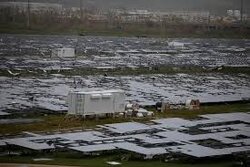New construction in many areas reportedly require steel reinforcements straps that run from the foundation, up over the plates and then continuing up the wall and then wrapping over the roof rafters. I think they also use a lot more reinforcing clips in place of nailing and a lot of construction adhesives. There is a lot of attention paid on holes in walls like where windows used to be after a projectile hit it. What happens is the wind get inside the house and blows out the roof or walls from the inside. I think hurricane shutters are pretty well mandatory now in high wind areas.
Buildings usually fail due to bad details, details cost money so builders tend to skip over them unless the inspector is watching. Florida reportedly had very weak local building codes with weak enforcement pre Andrew as much of the expansion was into rural areas that didn't have the governments they needed to make sure it was done right and its that older stock of homes and buildings that probably bore the brunt. Most folks would rather pay for granite counters then pay a bit more for better building so that's what the builders do. The builders know they are long gone before the next hurricane, so all the need to do is hope the inspector doesn't tag them on shortcuts.
Structures can be built to survive high winds.
Yes, they can. Many old homes in FL can also be retrofit, if you can find an older structural PE who understands high wind zones and is willing to work with you. After Hurricanes Frances, Jeanne, and Wilma, my wife and I were able to work with a PE to retrofit our 1962 two story, combination concrete block and wood frame home. You definitely want some form of steel providing a connection from the foundation on up, and clips securing the rafters to the top plate. For my house, a retrofit meant unwrapping the entire second floor (all the sheathing off) so threaded rods could be epoxied into the poured top beam on the concrete block first story. Those threaded rods go up through the walls with nuts on top of the top plate of the wood framed walls. The rods are capped with hurricane washers and nuts "finger tight", not torqued. The hurricane clips tie the rafters to the top plate, and rest assured the inspectors count nails. Inspectors in my little town have always been sticklers, but post Andrew was a whole new level of attention to detail.
As I listen to the daily news reports of Puerto Rico, I can't help but think: America has the technology to fix this. Electric can be run underground just as water and sewer are. It's not rocket science. We may need to develop a whole new foundation system for ground mounted transformers, to give them some level of flood resistance, but that is not too problematic. (right now, a ground mounted power transformer to feed a neighborhood typically uses a slab on grade foundation). Do you really need to put some of the infrastructure back? Is there a reason to put wire based phones back at all? If you're replacing cabling for internet and television, put fiber in, and put it underground.
The real question becomes, whether distributed renewable energy systems become more economical to reattach the outlying communities than burying the grid to get power back to them? I know where our second home is, in Northern Maine, outlying properties can have very steep connection costs to bring the grid to them, and that is with overhead wiring. Every major hurricane points out the issue with overhead wiring in wind prone areas. A large enough force (high wind) pressing on an old wooden lever arm (power pole), tends to snap them off. Throw in wind borne debris, and survival gets very tough on any utility wiring overhead.
As for technology to make hurricane damaged areas habitable in the short term, I see opportunities for people making competition for SunDanzer refrigerators. Low power consumption refrigeration cooling systems capable of running off a combination of solar and stored battery power exist.


 .
. 